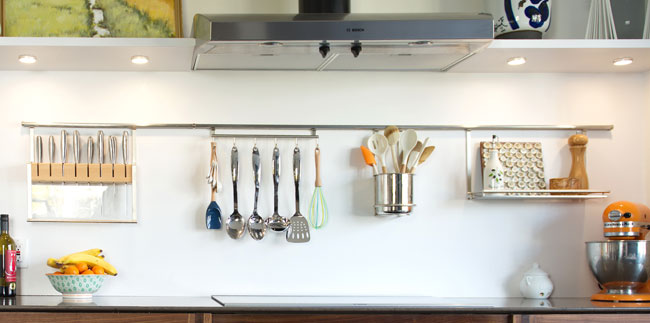1.800.667.8721 or Live Chat (9AM - 6PM EST)
Buying Guide: How to Choose Cabinet Lighting
 Cabinetry can interfere with your kitchen's overhead lighting, casting shadows over countertops where you need the brightest surface. By supplementing existing lighting, an under cabinet installation will illuminate your task area and backsplash, while the cabinet's valence easily conceals wires and prevents glare. Lower light levels or dimmable options also serve as great night lights. Cabinet lighting can completely transform your kitchen, though it may be difficult to decide where to begin! There are three types of bulbs, also called lamps, to consider: halogen (incandescent bulbs), fluorescent and LED. The type of lamp influences the fixture's color, bulb life, amount of light and energy usage and often determines the style of the fixture.
Cabinetry can interfere with your kitchen's overhead lighting, casting shadows over countertops where you need the brightest surface. By supplementing existing lighting, an under cabinet installation will illuminate your task area and backsplash, while the cabinet's valence easily conceals wires and prevents glare. Lower light levels or dimmable options also serve as great night lights. Cabinet lighting can completely transform your kitchen, though it may be difficult to decide where to begin! There are three types of bulbs, also called lamps, to consider: halogen (incandescent bulbs), fluorescent and LED. The type of lamp influences the fixture's color, bulb life, amount of light and energy usage and often determines the style of the fixture. Types of Cabinet Lighting
Halogen: Halogen lamps are a type of incandescent light, the most common source found in homes. Available in different wattages, halogens have a cooler appearance (less yellow) than most incandescents. Inexpensive and readily available, halogens typically have the shortest lifespan and use more energy than its peers. According to the Lighting Research Center, incandescents last two years on average, at three hours of use per day. Halogens also emit more heat, but produce an appealing, strong light and are dimmable.- Types of Halogens available:
- Puck Lights: These short cylinders are perfect for cabinet and display lighting. They feature a low-profile silhouette available in an array of subtle finishes, or as recessed-mounts that will be flush with your ceiling or cabinet. Be careful to create uniform spacing (8-12 inches apart is recommended) to avoid dark spots.
- Types of Fluorescents available:
- Linear Lighting: Available in a multitude of lengths and depths, fluorescent linear lights sport a low profile that is easily concealed behind the cabinet valence. The housing or lens can be adjusted for different lighting angles, and some are available with high and low light settings as an alternative to dimming.
- Compact Puck Lighting: Fluorescent lighting is also available in a puck shape, typically with 9-Watt replaceable lamps. These fixtures use less energy and produce more light than their incandescent counterparts. Opposed to the 8-12 inch range for halogens, fluorescent pucks can be spaced as far as 16-inches apart.
LED Technical Q & A
LED Light Effect Technology Info
LED Technical Terms
- Types of LEDs available:
- Puck Lights: Several LED lamps are present in one puck fixture. A well-designed puck can last 20 years or longer, but the whole thing must be replaced when lamps eventually do burn out. Most LED accent lights are available in a dimmable option.
- Linear Lighting: LED linear lighting is available in the form of a rigid or flexible strip. They sport a super low-profile, but remember to use included mounting brackets to attach your strip (LEDs emit heat, so they will burn out faster if not able to breathe).

Money Talk
When considering your cost, remember to factor in the initial cost of the bulb, power needed for cabinet, complexity of installation, annual replacement cost and annual energy cost. This table, produced by the Lighting Research Center, breaks down what you might expect to pay for each option:
Things to Consider
Dark colored countertops absorb more light while lighter surfaces are naturally brighter. For this reason, opt for stronger lights on darker countertops. Glossy surfaces are more reflective, but can often be uneven, so choose a lens-covered source (like a puck or strip) over a bare bulb to reduce this effect. Also, keep color in mind. For wood tones, warm tiles or copper backsplashes, a warm white lamp is favorable (2700-3500 Kelvin). For glass, cool tiles, stainless steel or other silver metals, opt for a cool white lamp (2500-5000 Kelvin). Last, consider dimming capability. This enhances your cabinet lighting experience, allowing you to slightly illuminate your kitchen at night or offer bright light when preparing food. Remember that dimming is easily added to Incandescent or LEDs but may be a costlier effect for fluorescents. For more help on choosing or installing cabinet lighting, Contact Us to speak with an expert customer service associate.




